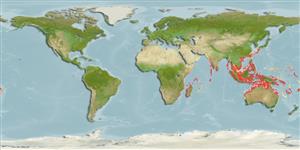Actinopterygii (ray-finned fishes) >
Scorpaeniformes (Scorpionfishes and flatheads) >
Scorpaenidae (Scorpionfishes or rockfishes) > Scorpaeninae
Etymology: Scorpaenopsis: Latin, scorpaena = a kind of fish, 1706 + Greek, opsis = appearance (Ref. 45335); ramaraoi: Named in honor of the late Kaza V. Rama Rao who assisted in the early research on Scorpaenopsis. Not in Ref. 40966.. More on author: Randall.
Environment / Climate / Range
Ecology
Marine; demersal; depth range 1 - 60 m (Ref. 42181). Tropical, preferred ?
Indo-West Pacific: Pakistan and Sri Lanka to New Britain, Papua New Guinea (Ref. 42181).
Size / Weight / Age
Maturity: Lm ? range ? - ? cm
Max length : 20.8 cm TL male/unsexed; (Ref. 90102)
Dorsal
spines
(total): 12;
Dorsal
soft rays
(total): 9;
Anal
spines: 3;
Anal
soft rays: 5. Distinct median interorbital ridge. No extra spine anterior to each tympanic spine; occipital pit shallow, not quadrangular. Ridge above anterior lacrimal spine with a pointed tip. Upper opercular spine single, narrow and without a median ridge. Space between opercular spines without ridges. Supraocular tentacle well-developed. Longitudinal scale series 45-49 (Ref 42181).
Collected from both silty sand and rocky bottom; also from areas with coral (Ref. 42181). Inhabits rock or coral bottoms in 1-60 m (Ref 90102).
Life cycle and mating behavior
Maturity | Reproduction | Spawning | Eggs | Fecundity | Larvae
Randall, J.E and W.N. Eschmeyer, 2001. Revision of the Indo-Pacific scorpionfish genus Scopaenopsis, with descriptions of eight new species. Indo-Pac. Fish. (34):79 p. (Ref. 42181)
IUCN Red List Status (Ref. 115185)
CITES (Ref. 94142)
Not Evaluated
Threat to humans
Harmless
Human uses
More information
Common namesSynonymsMetabolismPredatorsEcotoxicologyReproductionMaturitySpawningFecundityEggsEgg development
ReferencesAquacultureAquaculture profileStrainsGeneticsAllele frequenciesHeritabilityDiseasesProcessingMass conversion
Tools
Special reports
Download XML
Internet sources
